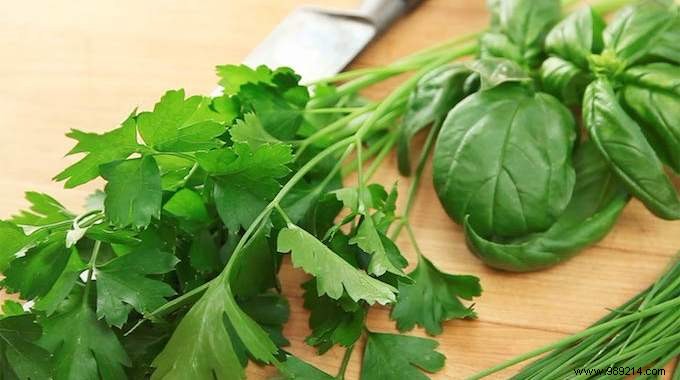
Herbs are essential in the kitchen.
The problem is that we don't always know which ones to choose when preparing a dish.
Luckily, here's the handy guide that tells you which herbs to use for which dish.
It's a good way to improve your cooking skills easily.
This table indicates which herb to use for a particular dish but also which oil to use.
Some combinations may seem obvious, such as the association between chocolate and mint. But others are less so, such as ginger and dill.
Here is the guide to know which herbs to use for each of your dishes and never get the seasoning wrong again. Watch:

If you want to print this guide in PDF, click here.
As any chef would tell you, choosing the right mix of herbs and spices is essential to a successful dish.
But for beginners, the use of fresh herbs is far from obvious.
This guide shows you which aromatic herbs you should have at home and which ingredients go well together to succeed your seasoning .
To facilitate the use of this guide, the herbs are grouped under different color codes:
- Good matches are in grey.
- Flavors that complement each other are in green.
- Recipe ideas and tips are in yellow.
- The best oils to use are in purple.
Good combinations:
White meats
Raspberries
Strawberries
Roast beef
Turkey
Lamb
Flavours that complement each other:
Tomatoes
Thyme and oregano
Fennel and oregano
Recipe ideas:
Stir-fried dishes
Italian dishes
Pesto
To decorate
The best oils to use:
Grape seed oil
Sesame oil
Olive oil
Nut oil
Rapeseed oil
Good combinations:
Salmon
Carrots
Cucumbers
Yogurt
The flavors that complement each other:
Mustard
Pepper
Pepper
bay leaves
Cloves
Ginger
Chive
Cinnamon
Parsley
Mace
Recipe ideas:
Borscht or other stews
Vegetable and pickle salads
The best oils to use:
Colza oil
Safflower Oil
Good combinations:
Pork
Potatoes
Peas
Chocolate
Fruit
The flavors that complement each other:
Ginger
Pepper
Cumin
lemon verbena
Chamomile
Recipe ideas:
Icing
Cakes
Pies
The best oils to use:
Colza oil
safflower oil
Nut oil
Coconut Oil
Good combinations:
Beef
Chicken
Fried fish
Pork
Roast beef
Turkey
The flavors that complement each other:
Pepper
bay leaves
Thyme
Fennel
Basil
Recipe ideas:
Tomato sauce
Pizza
The best oils to use:
Colza oil
Avocado oil
Safflower Oil
Good combinations:
Grilled fish
Pork
Roast beef
Turkey
Cauliflower
Potatoes
Tomatoes
Spinach
Roasted meats
Mushrooms
Beef
The flavors that complement each other:
Oregano
Thyme
Garlic
Recipe ideas:
Add to sauces
To stuff poultry
The best oils to use:
Colza oil
Olive oil
Corn Oil
Good combinations:
Sweet fruits and vegetables (e.g. squash and apples)
Sausages
Fried fish
Pork
Turkey
Cheese
Beef
The flavors that complement each other:
Lemons
Winter Savory
Recipe ideas:
Perfect herb for recipes that cook for a long time
For the pranks
Sausages
Roast pork
Burgers
The best oils to use:
Colza oil
Avocado oil
Safflower Oil
Good combinations:
Chicken
Fried fish
Pickles
Tomatoes
The flavors that complement each other:
Parsley
Chervil
Chives
recipe ideas:
Sauces for meats and vegetables
Dishes with eggs and cheese
Green salads
The best oils to use:
Colza oil
Avocado oil
Safflower Oil
Good combinations:
Eggs
Lamb
Grilled fish
Roast beef
Turkey
Pork
The flavors that complement each other:
Laurel
Rosemary
Oregano
Marjoram
Sumac
Coriander
Recipe ideas:
Beans
For vegetarian dishes
Eggs
The best oils to use:
Colza oil
Safflower Oil
Good combinations:
Beef
Chicken
Grilled fish
Pickles
Pork
The flavors that complement each other:
Ginger
Cinnamon
Cumin
Cardamom
Chilli
Recipe ideas:
Salads
Apple pies
To prank
Sausages
The best oils to use:
Colza oil
safflower oil
Sunflower oil
Good combinations:
Fish
Chicken
Potatoes
Vegetables
Eggs
The flavors that complement each other:
Basil
Chive
Tarragon
Recipe ideas:
Pasta dishes
Soups
The best oils to use:
Colza oil
safflower oil
Butter
There you go, now you know which herbs to put in which dishes :-)
Easy, fast and practical as a guide, right?
In addition, using aromatic herbs is very good for your health!
Yes, all herbs and spices have virtues on the body. Here are some examples:
3 Unexpected Benefits of Basil:Beauty, Health, Well-Being.
The 3 virtues of mint that you don't know.
According to a Study:Smelling Rosemary Increases Memory by 75%.
The Virtues of Thyme, a Plant that Should Come Out of the Kitchen.
The aromatic herbs in the supermarket or on the market are not cheap!
But why buy them when you can grow them for free at home with just water? Find out how here.
Here we also explain how to grow them at home easily.
Or else you can also get an indoor vegetable garden like this.
In any case, once you have some at home, remember to keep them well with this trick so as not to waste them!